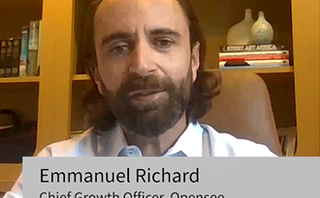ASX, SGX earnings driven by diversified revenue
After the Chess disaster, ASX focuses on rebuilding confidence, while SGX continues investing in its derivatives business. Meanwhile, HKEx mulls data play.

In line with the trend for some of the major global exchanges to diversify revenue streams away from transaction and listing revenues, both the Australian Securities Exchange (ASX) and the Singapore Exchange (SGX) are already benefiting from doing so despite the challenging market and economic environment.
SGX reported an 8.7% year-on-year increase in revenue to S$1.2 billion ($877 million) for the full financial year ended June 30, mainly driven by derivatives revenue, which includes equity derivatives, currencies and commodities futures and options trading, as well as clearing revenue and associated treasury income.
Equity derivatives revenue grew 17% to S$363.1 million, accounting for 30.4% of total revenue, while currencies and commodities revenue increased 37.1% to S$329.9 million, accounting for 27.6% of the exchange’s total revenue for the 2023 financial year.
Meanwhile, its over-the-counter foreign exchange volumes achieved a record average daily volume (ADV) of $76 billion during the financial year, which SGX believes accelerates its target of hitting $100 billion by FY25 or earlier.
During SGX’s results briefing on August 17, CEO Boon Chye Loh said the exchange’s multi-asset strategy continues to provide market participants with diverse investment and risk management tools in the challenging macro environment.
“This is reflected in our diversified revenue streams, with strong performance in our derivatives businesses across equities, commodities, and FX, amid lower activity in our cash, equities and index businesses,” he said.
Meanwhile, ASX recorded a 1.2% drop in operating revenue to A$1.01 billion ($645 million) for the full financial year ended June 30.
Helen Lofthouse, managing director and CEO of ASX, said this was achieved despite challenging market conditions. “This result again showed the strength of our diversified business model with revenue growth in listings and technology and data offset by a decline in our markets and securities and payments businesses,” she said.
ASX’s technology and data business grew 8.5% to A$240.8 million, while the listings business was 2.2% higher than a year ago. Operating revenue was dragged lower by its markets business, as well as securities and payments business, which fell 2.1% and 10.4%, respectively.
This time last year was when Lofthouse took the helm at ASX while the exchange was still reeling from its November 2022 decision to abandon its Chess-replacement project. Since then, Lofthouse has made eight new appointments to her executive team, including Diona Rae as COO, and Clive Triance, ASX’s new group executive for securities and payments, who started his role earlier this month after relocating from London.
Time to rebuild
The exchange, marred by the failure of the Chess DLT replacement project, is now focused on rebuilding confidence with its stakeholders.
“Since taking the difficult but necessary decision to pause Chess replacement last November, we acknowledge that confidence in ASX has been tested. It is a key priority for me and my executive team to ensure we’re taking action that will restore trust amongst our stakeholders, including our regulatory agencies. Part of this has been publishing important reports that provide additional transparency on our existing arrangements and how we are changing and improving,” Lofthouse said.
Two near-term focus areas for the exchange are regulatory commitments and technology modernization. Lofthouse added that “we will need to get these right” to ensure it continues rebuilding confidence.
ASX has shifted its approach to take an enterprise view by investing in technology platforms instead of concentrating on individual projects. “By investing in platforms such as digital, data and cloud, we can significantly increase automation and re-use between business lines, improving the speed of implementation and ultimately managing our underlying risks more effectively,” she said.
Looking at cloud, for example, ASX has adopted an expanded role for cloud services to address the delivery of scaled infrastructure and the rapid software development for ongoing technology programs.
One of the programs involves upgrading its OTC derivatives clearing platform, for which it will undertake an initiative to engage with stakeholders.
As for the Chess replacement project, which remains a significant goal within ASX’s enterprise technology roadmap, it is working on a solution and will announce it later this year.
ASX reiterated on June 27 that it is assessing four solution archetypes—fix the Chess replacement, build a custom solution, build a product-based solution, or iterate over legacy Chess.
Lofthouse said the exchange is refining those archetypes against a solution-decision framework and gathering further industry input on items such as scope and implementation approaches.
She stressed that even once the solution design has been determined, ASX will continue reaching out for industry input for the next phase of the project—a key focus in 2024.
Data rich
On data, Lofthouse explained that the exchange’s technology and data business supplied data for an increasing range of financial market use cases.
“Today we support a broad array of pre-trade and post-trade functions with machine-readable data as our customers increasingly seek to automate the entire trading lifecycle. ASX data continues to be a fundamental input into the way our customers analyze the Australian markets to derive insights and generate better returns,” she said.
ASX also sees increased use of ASX reference data and market activity data within third-party applications to help market participants carry out risk and compliance activities.
To a question from an analyst on increasing reference data demand, Lofthouse said she sees customers increasingly looking to automate their processes and find ways to capture machine-readable data from different parts of the value chain.
“I expect that to be a continuing trend. And so, focusing on how can we really harness more and more of this great data that we have in ways that are entirely appropriate, but also actually give customers the flexibility to use it in the way they want to. I think that’s still a significant opportunity for us,” she said.
For SGX, its data, connectivity, and index business contributed about 12% of its 2023 revenue. SGX’s Loh said the market data business grew due to an increase in non-display usage licenses and distribution of commodities data, but lower revenues from its index business offset that.
However, he added that the group believes that the index industry remains attractive, touting Scientific Beta’s research expertise and IP creation as key for building “cutting edge” risk management index solutions. In 2020, SGX bought a 93% stake in Scientific Beta, a smart beta index firm, for S$280 million.
“Notwithstanding the current macro environment, we believe there are still opportunities for smart beta indices to help investors diversify and balance their portfolios,” Loh said.
Meanwhile, in response to a question from WatersTechnology during the Hong Kong Exchanges and Clearing (HKEx) results briefing on August 16 about the exchange’s data strategy and monetization efforts, CEO Nicolas Aguzin highlighted that its data and connectivity sector represents around 10% of revenue.
The “beauty” of that sector is that it continues to grow steadily, Aguzin said. One of the things HKEx has done is to ensure that its participants can co-locate some of their servers at HKEx, while also expanding the capacity of its hosting services.
Regarding potentially monetizing its data, Aguzin said the exchange is still deliberating on its plans.
“This is a sector that we’ve been reviewing actively, and we do have plans in terms of enhancing the offering that we have to the market—in some cases making it more accessible, and in other cases adding value to the data [so] that we can provide richer, broader data to the market as a whole,” he said.
HKEx recorded a 5% increase in core business revenue to HK$9.7 billion ($1.24 billion) for the first half of the 2023 financial year, mainly supported by net investment income and derivatives ADV.
Further reading
Only users who have a paid subscription or are part of a corporate subscription are able to print or copy content.
To access these options, along with all other subscription benefits, please contact info@waterstechnology.com or view our subscription options here: http://subscriptions.waterstechnology.com/subscribe
You are currently unable to print this content. Please contact info@waterstechnology.com to find out more.
You are currently unable to copy this content. Please contact info@waterstechnology.com to find out more.
Copyright Infopro Digital Limited. All rights reserved.
You may share this content using our article tools. Printing this content is for the sole use of the Authorised User (named subscriber), as outlined in our terms and conditions - https://www.infopro-insight.com/terms-conditions/insight-subscriptions/
If you would like to purchase additional rights please email info@waterstechnology.com
Copyright Infopro Digital Limited. All rights reserved.
You may share this content using our article tools. Copying this content is for the sole use of the Authorised User (named subscriber), as outlined in our terms and conditions - https://www.infopro-insight.com/terms-conditions/insight-subscriptions/
If you would like to purchase additional rights please email info@waterstechnology.com
More on Data
IMD & IRD Awards 2023 winner's interview: Opensee
Opensee won the best risk data aggregation initiative in the annual IMD & IRD Awards for the second consecutive year, thanks to its Opensee Enterprise offering.
Fenics Market Data’s secret source
The ability of capital markets practitioners to make judicious business and investment decisions is directly determined by the quality of data underpinning those decisions. Fenics Market Data’s Rich Winter discusses the benefits of sourcing data from…
A Fireside Chat with FactSet's Jason Pangretic and Maurice Iragorri
Jason Pangretic and Maurice Iragorri discuss data and analytics, the critical role EMSs play across the buy side, and system integration and interoperability.
Waters Wavelength Podcast: Episode 262 (Previewing Nafis)
Wei-Shen and Tony take a look at what’s to come at the North American Financial Information Summit (Nafis).
Smashing barriers: How shortwave frequencies are making trading firms faster
Improvements in shortwave radio frequencies could be a leap forward in the latency race. But given the costs and technical challenges, is it worth the investment?
LSEG’s take on decentralized finance, data catalogs and managed data services
A number of London Stock Exchange Group’s senior business leaders spoke at the annual World Financial Information Conference, held recently in Prague. Stefan Reichenbach, John Mason, Janelle Veasey, Stuart Brown and Jason West, alongside others,…
Considerations for selecting a market data-as-a-service provider: End-users weigh in
In late September, WatersTechnology and FactSet held an exclusive, off-the-record roundtable discussion focusing on how capital markets firms can make the business case for subscribing to market data-as-a-service solutions. The discussion featured…
Combined data and analytics offer users the best of both worlds
Firms on both sides of the industry have never had it better when it comes to the variety of datasets available to them, either from individual data vendors or through exchange partnerships (such as the recent Deutsche Börse-CME Group alliance). However,…






3f0f.jpg)

